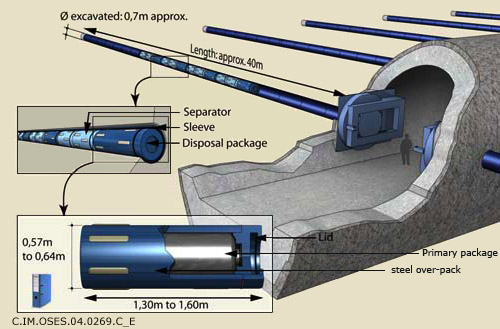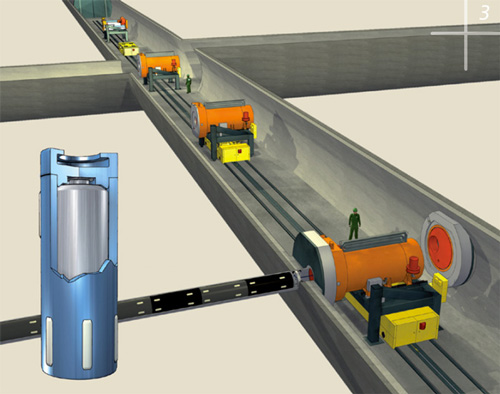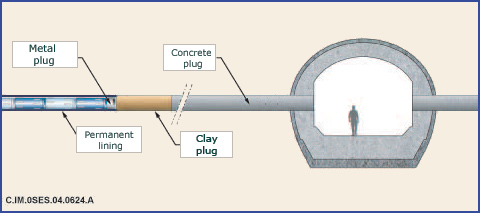High-level waste repositories
Disposal of high-level waste packages
The high-level waste packages requiring disposal will probably be the CDS-V vitrified waste containers currently produced at the La Hague plant. Packages arriving at the repository will initially be received in above-ground buildings, where they will be inspected and unloaded from their transport casks.
They will then be reinspected and placed in disposal packages. Before being transferred underground, disposal packages will be placed in casks to shield against radiation.
Each cask will be placed on a funicular and carried down an access ramp to the disposal facilities 500 m underground.
ANDRA video Route taken by HLW waste from reception to disposal cells
Waste will be placed in disposal cells by robotic systems. All of the aforementioned operations will be performed by robots with no humans present, due to the powerful gamma radiation emitted by the waste packages.
Dissipating the heat released by high-level vitrified waste packages is the key factor influencing the dimensions of a repository (A vitrified waste package releases around 500 W after 60 years in interim storage). The design and architecture of the repository modules for such waste aim to remove this heat into the surrounding rock, such that the maximum temperature reached in the argillite formation never exceeds 90°C.

High-level waste disposal cell
The disposal cell for high-level waste consists of a tunnel, approximately 70 cm in diameter and 40 m in length. The steel over-packs containing the primary waste packages are spaced out by separators. The number of disposal packages per cell, the spacing between consecutive disposal packages in a tunnel and the distance between tunnels are defined so as to ensure that the peak temperature in the argillite formation remains below 90 °C.
© ANDRA
The surface areas of several square kilometres envisaged for planned repository sites can be accounted for by the need to separate the waste containers in a disposal cell (unlike ILW-LL waste, which can be stacked) and to space out the disposal cells.
Disposing of spent fuel assemblies, which release comparatively more heat than vitrified waste, would require even larger areas. Conversely, implementing advanced separation to extract caesium and strontium from the vitrified waste packages produced in La Hague would considerably increase the repository’s capacity. These two fission products are the main sources of the heat released by waste during the critical initial period of around 100 years.

High Level Waste disposal containers
Before being emplaced in disposal cells, HL radioactive-waste packages are conditioned in disposal containers.
ANDRA
Waste will be disposed of on a single level located in the middle of the Callovo-Oxfordian layer in order to maximise the thickness of impermeable argillite above and below it. The disposal cells are blind tunnels that will be sealed when full. The access shafts will be grouped together on one side, and the filling areas as well as the general architecture of the disposal facilities will be based on a dead-end configuration. The disposal cells will be laid out so as to limit the temperature of the rock in contact with them to 100°C. Accordingly, the cells containing heat-releasing waste will have to be spaced out.

Spacing of high-level waste packages in a cell
High-level waste packages inside the narrow tunnel that forms a disposal cell are spaced out using separators. Disposal is reversible until the repository will be permanently closed. When the repository is closed, a plug of swelling clay and a concrete plug will isolate the tunnel from the access tunnel, which will also subsequently be sealed.
© ANDRA
ANDRA video (in french) : Sealing disposal cells in a CIGEO repository
Other articles on the subject « Geological disposal »
Waste duration
Nuclear spent fuel and vitrified waste: what legacy? « Much of this nuclear waste will remain haz[...]
CIGEO project
CIGEO – Overview of a planned repository The efforts made by engineers to ensure that highl[...]
Clay medium
The Callovo-Oxfordian argilite The geological stratum or ‘host rock’ that will[...]
Bure underground laboratory
A research laboratory for a disposal facility site Before high-level radioactive waste is buried [...]
Results on deep clay disposal
What we know about the disposal facility site In its final report in 2006 the French National Ass[...]
ILW-LL waste repositories
Filling an intermediate-level waste disposal cell Intermediate-level (ILW-LL) waste releases litt[...]
Waste disposal USA
Back to the drawing board after Yucca Mountain WIPP, the first deep geological repository to begi[...]
WIPP Project
The world’s first deep geological repository The United States is the first country in the [...]
Waste disposal Sweden
Sweden and Finland – Exemplary waste management Sweden probably features among the E[...]
Other countries
Shared challenges and similar solutions In most countries with nuclear industries, solutions for [...]